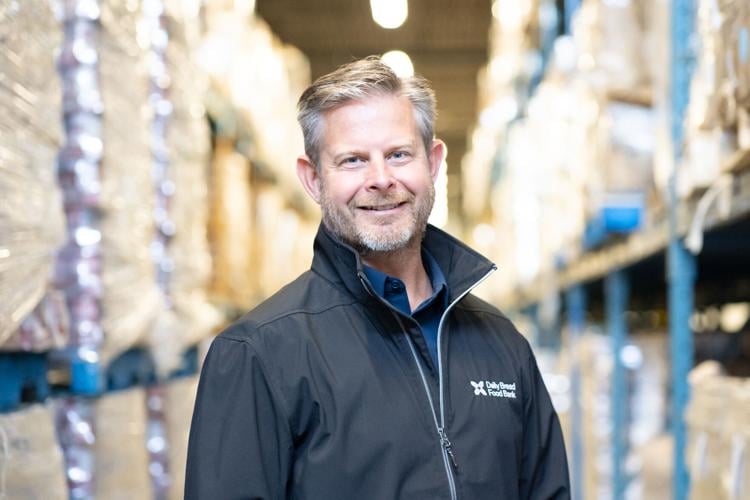One in 10 Torontonians now rely on food banks to help feed themselves. That statistic, which represents a 36 per cent increase in unique food bank clients compared to 2023, was among the findings in the Whoās Hungry 2024 report.
Released last month, the annual report is created in partnership between the Daily Bread Food Bank and North York Harvest Food Bank and provides a snapshot of food insecurity in the city.
āItās been horrific, weāve gone from serving some 55,000 to 60,000 client visits per month to over 330,000 per month,ā said Neil Hetherington, CEO of the Daily Bread Food Bank.
āIt has been difficult from an organizational perspective to keep up with demand, and itās been difficult from a city perspective knowing that there are so many people that are hurting so badly.ā
This yearās report found there were roughly 3.5 million food bank visits in the last year, a 273 per cent increase compared to before the COVID-19 pandemic, with 57 per cent of clients only beginning to access food bank support in the past 12 months. Roughly half of food bank users have someone in their family that is employed and 80 per cent are renters.
The Whoās Hungry Report 2024 also discovered that one-in-five people accessing food banks are spending all of their income on housing, leaving nothing for food, and that $7.78 is the median amount of money per person, per day, that clients have for food after paying their rent and utilities.
We recently spoke to Hetherington about the reportās findings, what is causing the increase in use, and what people can do to support their local food bank ā even during tough times.Ā

What struck you most about this yearās results?
Well, we have the difficult banner stuff ā that there were 3.5 million visits, and that was a million more than a year prior. So, from a headline perspective, that was significant. I think more telling, as you dive into the report, is that you start to see that 60 per cent have a university education, more than 50 per cent have had jobs, and they still have to make use of food charity.
I get pretty angered at the fact that the social contract that there used to be, that if you go to school and get a job and work hard, has been broken. And we see it every single day in the lineups outside of the Daily Bread Food Bank.
The report notes that there were a million more visits this year than the year prior. What is causing that?
There are a few reasons. Thereās a risk of oversimplifying a complex issue, but I would say it is a clear indication about a lack of affordable housing in the city. A few decades ago, we made the decision to stop building housing from a cooperative perspective, and a generation later weāre feeling it and itāll take two generations to repair that. So affordable housing is certainly a big thing.
The next is the disparity between incomes that people have, particularly on disability benefits, and what it costs to live in the city. If you are on disability, you receive $1,397 per month and the poverty line is just under $2,300 or $2,400 a month. So, folks that are in the most vulnerable state have been put in this position where, for some reason, we think they will be fine with an income that is $1,000 below the poverty line. When you have the cost of living increasing for people on fixed incomes, it becomes very, very difficult
Looking at the report, for several years prior to the pandemic, there were some ups and down but food bank usage was steady. What happened to cause the spike and will we recover to those pre-pandemic levels?
There better be. We need it to happen. During the pandemic a lot of people burned through saving or asked for favours from friends and family, and so theyāve got debts to pay. So, youāve got debts, a lack of savings, those types of things.
Then you compound that with cost-of-living increases and pretty extraordinary increases on rents. When units become vacant the lifts on some of those (rents) are dramatic. Like, if youāve left your premise and you were paying $1,500, that landlord is now asking $2,500. So those lifts have been significant.
There is definitely not one answer. Itās complex.Ā
What struck me in the report was the figure of $7.78 a day for food.
That one is frightening because itās an average. Think about it: āWell thatās an average, so what is going on with those at the lower side?ā We know from the report that over one-fifth of the people that come to the food bank have absolutely nothing after paying for rent and utilities. They have nothing. They are completely dependent on food charity, friends and family, for everything. Transportation. Clothing. Everything.Ā
How much has the increase in food costs affected your budget?
Itās been awful. Weāve gone from spending $1.5 million a year to $29 million a year on food. The vast majority of that is because of client increases, but we are talking about a 14.6 per cent increase year-over-year in food purchasing prices. It has the double whammy effect in that it drives more people to the food bank, and it costs more to serve them.
You spoke about the social contract being broken. What do you think that means for people?
I believe that on one side is individual responsibility to contribute to society, and for those who canāt, that the community will come together and rally. I think the contract has been broken on both sides of the equation, where somebody who has gone to university, has gone to college, has found a job and still canāt make ends meet. Thatās a broken contract. And, on the other side, we are not living the values we espouse as Canadians when we treat those on disability the way we do.Ā
Given the statistics and the cost of living, is it possible for the community to rally?
It is really very difficult. We see a number of individuals who have had to call us up and say, āListen,ā letās call it $20 a month as a donor, saying āI need to make that $15 a month.ā And you think, āOkay, thank you for the contribution you made.ā Thank you for continuing it given that alteration is going to have a positive impact on their finances.
The flip side is thereās a whole lot of folks in the city that you can call and say, āListen could you spare $1 million,ā who step up to the plate without even noticing that those funds have been depleted. It talks about a tale of two cities really.
We want to make sure that we feed the need now with every single one of those clients, and that means we go out for food and funds. We raise money with Giving Tuesday, but at the same time Giving Tuesday can also be giving your time to advocate for some change. And everybody can get back this Giving Tuesday by talking about the poverty reduction strategy with any elected official.Ā
The report notes that the situation has never been so grim, what effect has that had on you and your staff?
I canāt help but think about that person whoās in line at one of the Daily Breadās food banks across the city. Theyāve been put in a position where they are among the 155,000 Torontonians who went into that lineup for the very first time. I have a sense of anguish for each one of them having to make that decision for them and their family.
Iāll do my best to make sure that Daily Bread meets the need now. Iām sorry because Iām kind of hesitant about answering the question because I donāt want it to be about me, but it has been hard.
We have had to grow from raising $8.5 million dollars a year to $40 million a year just to maintain service levels, and thereās an enormous weight on the shoulders of every volunteer and staff member about that. If we donāt make the budget, if we donāt raise the food, that means people arenāt eating. So, like it or not, thereās a charitable stress there.
If a person wants to help, but isnāt sure how they can, what would be your advice to them?
I would hope that they would consider donating food or funds if they have the means to be able to do that. We would be very grateful, and we need it desperately, so that would be my request. Iām really proud that Daily Bread was listed as one of the top five national charities just last (month) by Charity Intelligence. Iām proud of that, so people know that the funds are well stewarded and the food is distributed quickly.
But not everybody can do that, and so in those cases Iām hopeful that they would consider volunteering with us. And, most importantly, it doesnāt matter what your income level, it doesnāt matter who you are or where you live, we can write any elected official, of any party, at any level of government and say, āToday is the day to implement the poverty reduction strategy and take it seriously.ā
And hopefully, what each politician starts to say is, āThe legacy I want to leave is a reduction in the number of people who need a food bank.ā
ED NOTE: This interview has been edited for length and clarity




























